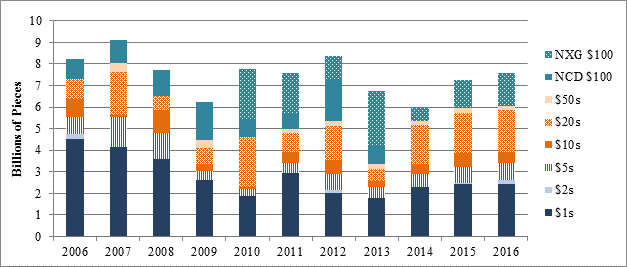2016 Federal Reserve Note Print Order
The Board of Governors (the Board), as the issuing authority for Federal Reserve notes, approved and submitted its fiscal year (FY) 2016 order for nearly 7.6 billion Federal Reserve notes, valued at $213.3 billion, to the U.S. Treasury Department’s Bureau of Engraving and Printing (BEP) on July 24, 2015.1
The nearly 7.6 billion notes included in the FY 2016 order reflect the Board’s estimate of net demand for currency from domestic and international customers. The print order is determined by denomination and is based on destruction rates and historical payments to and receipts from circulation. Historically, the majority of the notes that the Board orders each year replace unfit currency that Reserve Banks receive from circulation.2 The estimated number of notes that Reserve Banks will destroy accounts for about 70 percent of the proposed FY 2016 print order and includes both unfit currency, as well as all old-designs of some denominations received from circulation.3 The expected growth of Reserve Bank net payments (payments less receipts) to circulation and inventory management adjustments account for the remainder of the notes in the FY 2016 print order. The table below reflects the denominational breakdown of the Board’s FY 2016 order.4
| Denomination | Number of Notesa (000s of pieces) |
Dollar Value (000s of dollars) |
|---|---|---|
| $1 | 2,425,600 | $2,425,600 |
| $2 | 179,200 | $358,400 |
| $5 | 819,200 | $4,096,000 |
| $10 | 480,000 | $4,800,000 |
| $20 | 1,939,200 | $38,784,000 |
| $50 | 224,000 | $11,200,000 |
| $100 | 1,516,800 | $151,680,000 |
| Total | 7,584,000 | $213,344,000 |
The Board’s order of nearly 7.6 billion notes is largely unchanged from the FY 2015 order and represents an increase of only 0.4 billion notes, or 5 percent. The FY 2016 order reflects continued stable growth of currency in circulation. Transactional denominations ($1, $5, $10, and $20 notes) account for 75 percent of the FY 2016 order, $50 and $100 notes account for another 23 percent, and $2 notes account for the remainder of the order. The order for $100 notes reflects a return to a more normal order following an order in FY 2015 that was lower than normal to compensate for excess inventories that followed the large amount produced in preparation for the issuance of the new-design $100 note in October 2013.
Appendix
Chart 1
Fiscal Year Print Orders
Footnotes
1. The BEP operates on a fiscal year that begins on October 1 and ends on September 30. The Board submits its annual order for Federal Reserve notes at least 60 days before the beginning of the BEP’s fiscal year. Return to text.
2. Unfit notes are notes that are received in deposits from depository institutions that are destroyed because they do not meet the Federal Reserve’s quality criteria for recirculation. Return to text.
3. New fitness and authentication sensors at the Reserve Banks have resulted in fewer notes being prematurely destroyed. Between 2011 and 2015, the Reserve Banks replaced all fitness and authentication sensors with new state-of-the-art sensors. The implementation of this new sensor suite decreased destruction rates by more than two percentage points and reduced the number of notes destroyed by nearly 0.5 billion, annually. Return to text.
4. Chart 1 in the appendix shows the Federal Reserve’s print orders between FY 2006 and FY 2016. Return to text.
